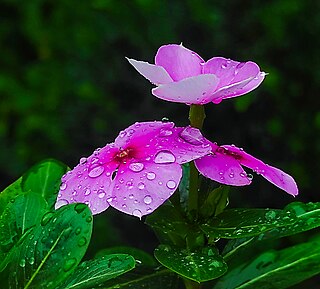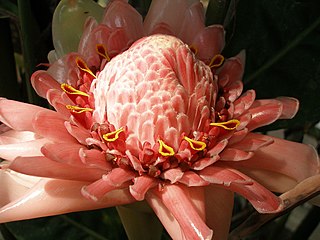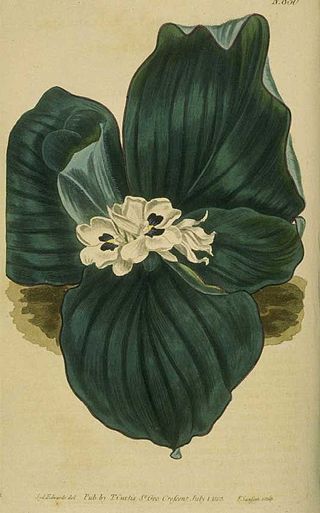
The order Lamiales are an order in the asterid group of dicotyledonous flowering plants. It includes about 23,810 species, 1,059 genera, and is divided into about 25 families. These families include Acanthaceae, Bignoniaceae, Byblidaceae, Calceolariaceae, Carlemanniaceae, Gesneriaceae, Lamiaceae, Lentibulariaceae, Linderniaceae, Martyniaceae, Mazaceae, Oleaceae, Orobanchaceae, Paulowniaceae, Pedaliaceae, Peltantheraceae, Phrymaceae, Plantaginaceae, Plocospermataceae, Schlegeliaceae, Scrophulariaceae, Stilbaceae, Tetrachondraceae, Thomandersiaceae, Verbenaceae.

Turmeric, ,) is a flowering plant in the ginger family Zingiberaceae. It is a perennial, rhizomatous, herbaceous plant native to the Indian subcontinent and Southeast Asia that requires temperatures between 20 and 30 °C and high annual rainfall to thrive. Plants are gathered each year for their rhizomes, some for propagation in the following season and some for consumption.

Zingiberaceae or the ginger family is a family of flowering plants made up of about 50 genera with a total of about 1600 known species of aromatic perennial herbs with creeping horizontal or tuberous rhizomes distributed throughout tropical Africa, Asia, and the Americas. Many of the family's species are important ornamental, spice, or medicinal plants. Ornamental genera include the shell gingers (Alpinia), Siam or summer tulip, Globba, ginger lily (Hedychium), Kaempferia, torch-ginger Etlingera elatior, Renealmia, and ginger (Zingiber). Spices include ginger (Zingiber), galangal or Thai ginger, melegueta pepper, myoga, korarima, turmeric (Curcuma), and cardamom.

Ginger is a flowering plant whose rhizome, ginger root or ginger, is widely used as a spice and a folk medicine. It is a herbaceous perennial which grows annual pseudostems about one meter tall, bearing narrow leaf blades. The inflorescences bear flowers having pale yellow petals with purple edges, and arise directly from the rhizome on separate shoots.

Myoga, myoga ginger or Japanese ginger is the species Zingiber mioga in the family Zingiberaceae. It is a deciduous herbaceous perennial native to Japan, China, and the southern part of Korea. Only its edible flower buds and flavorful shoots are used in cooking. The flower buds are finely shredded and used in Japanese cuisine as a garnish for miso soup, sunomono, and dishes such as roasted eggplant. In Korean cuisine, the flower buds are skewered alternately with pieces of meat and then are pan-fried.

Phyllanthus emblica, also known as emblic, emblic myrobalan, myrobalan, Indian gooseberry, Malacca tree, or amla, from the Sanskrit आमलकी (āmalakī), is a deciduous tree of the family Phyllanthaceae. Its native range is tropical and southern Asia.

Moringa oleifera is a fast-growing, drought-resistant tree of the family Moringaceae, native to the Indian subcontinent and used extensively in South and Southeast Asia. Common names include moringa, drumstick tree, horseradish tree, or malunggay.

Catharanthus roseus, commonly known as bright eyes, Cape periwinkle, graveyard plant, Madagascar periwinkle, old maid, pink periwinkle, rose periwinkle, is a perennial species of flowering plant in the family Apocynaceae. It is native and endemic to Madagascar, but is grown elsewhere as an ornamental and medicinal plant, and now has a pantropical distribution. It is a source of the drugs vincristine and vinblastine, used to treat cancer. It was formerly included in the genus Vinca as Vinca rosea.

Etlingera elatior is a species of herbaceous perennial plant in the family Zingiberaceae; it is native to Indonesia, Thailand, Malaysia and New Guinea.

Hodgsonia is a small genus of fruit-bearing vines in the family Cucurbitaceae.

Alpinia officinarum, known as lesser galangal, is a plant in the ginger family, cultivated in Southeast Asia. It originated in China, where its name ultimately derives. It can grow 1.5 to 2 m high, with long leaves and reddish-white flowers. The rhizomes, known as galangal, are valued for their sweet spicy flavor and aromatic scent. These are used throughout Asia in curries and perfumes, and were previously used widely in Europe. They are also used as a herbal remedy.

Kaempferia galanga, commonly known as kencur, aromatic ginger, sand ginger, cutcherry, is a monocotyledonous plant in the ginger family, and one of four plants called galangal. It is found primarily in open areas in Indonesia, southern China, Taiwan, Cambodia, and India, but is also widely cultivated throughout Southeast Asia.

Buchanania cochinchinensis, commonly known as charoli nut, almondette, Cuddapah almond, calumpong, Hamilton mombin, is a deciduous tree of the cashew family. The charoli tree is native to the Indian subcontinent, South Central China, and much of Southeast Asia.

Oroxylum indicum is a species of flowering plant of the monotypic genus Oroxylum in the family Bignoniaceae. It is commonly called Indian trumpet tree, oroxylum, Indian trumpet flower, broken bones, scythe tree or tree of Damocles. It can reach a height of 18 metres (59 ft). Various segments of the tree are used in traditional medicine.

Ichnocarpus frutescens is a species of flowering plant in the dogbane family Apocynaceae, known by the English common name black creeper. It is native to much of China, India, Southeast Asia, and northern Australia.

Kaempferia is a genus of plants in the ginger family. It is native to China, India, and Southeast Asia.
The following outline is provided as an overview of and topical guide to herbs and spices:

Hypericum hookerianum, or Hooker's St. John's Wort, is a perennial shrub in the flowering plant family Hypericaceae native to eastern and southern Asia. The specific name hookerianum is named for William Jackson Hooker.
Piper sylvaticum is a climber in the Piperaceae, or pepper, family. It is found in the northeast of the Indian subcontinent, and in Zhōngguó/China. The fruits are used in medicinal products.

Samadera indica, the bitter wood or Niepa bark tree, is a species of plant in the family Simaroubaceae. It is a shrub or tree and grows primarily in wet tropical regions, from west Africa, through India, then down through Indonesia to Malesia.


















